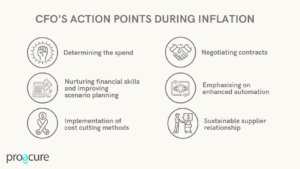CFO’s guide for efficient procurement during Inflation
Sanjay Agarwal | August , 2022

CFOs are attempting to diversify and rationalize procurement amid the continuous upheaval, by concentrating on optimizing product design costs and those of raw resources.

Inflation is one of the most significant challenges that businesses are currently dealing with. There has been a considerable shift in consumer demand, disruptions in the supply chain, and major complications from the ongoing pandemic event. These dynamic variations have contributed to inflation and have increased uncertainty and volatility.
The beginning of 2022 made it increasingly clear that inflation rates would be substantially higher than what the planners had come to expect, at 2.0 percent. In an article published by McKinsey recently, it was shown that in the US, the consumer price index increased by 8.5 percent between March 2021 and March 2022. Price increases have impacted the procurement leaders predominantly over the years. When compared to opportunistic price rises, inflationary situations make it difficult for buyers to estimate the price increases required by their suppliers to combat inflation. The CFO’s who had been relying on the price hikes as their principal approach while tackling inflation are now acknowledging that if long term inflation endures, then this approach would be unstable.
According to a survey by Gartner in May 2022, if the above-average inflation persists into this year’s fourth quarter, then the senior finance leaders and the CFOs will look into cost reductions while simultaneously considering efficiency benefits through enhanced automation. CFOs are currently focusing on nurturing the financial skills of the next generation and improving ventures related to scenario planning. There is a requirement to apply various strategies to negotiate prices with the suppliers if the inflation persists. The CFOs should pivot to optimizing the cost of product designs and raw materials. Along with that, the negotiation regarding price techniques should differ based on whether the long-term buying contracts are inflation indexed. They are looking for rationalizing and diversifying procurement, emphasizing on expanding the company’s supplier base and securing critical forward contracts. Besides, they are making a paradigm shift towards virtualisation of various functions and also building sustainable supplier relationships.
Cross-functional Collaboration and improved spending visibility required to ensure growth
Determining the spend, implementing cost-cutting efforts, and negotiating contracts with the external supply chain partners would help CFOs explore mitigating initiatives and sustain the business while looking for growth. McKinsey stresses the need for procurement organizations to proceed with cross-functional collaboration that would help generate effective responses. The most critical requirement would be to break down the divisions and increase Spend visibility across functions. Efficient procurement accelerates the effectiveness and visibility of the business. It enables them to gain a better understanding of their finances and make more confident, well-informed decisions.
Spend visibility steers the results of a business by increasing profits and lowering costs. It helps in supplier management by taking strategic decisions on sourcing and value addition, thus mitigating expenses by a significant margin.

According to Aberdeen (2004), almost 90% of businesses continue to utilize basic spreadsheet software as their primary analytical tool, limiting the scope and depth of studies that may be performed. It is estimated that poor expenditure data management skills cost organizations $260 billion in missed savings possibilities each year. Even today, a lot of businesses fail to understand the importance of data visibility.
With 100% transparency of your strategic and tail spend across business divisions and categories, it helps you get targeted insights and opportunities around diversity, compliance, savings, and more, implementing them and tracking them to your bottom line. Spend visibility is the foundation of superior procurement performance since it provides insights into the key components of expenditure categories.
CFO’s are focusing on digital cost transformation to stimulate growth
The Spend Cube facilitates a business to obtain a graphical representation of the results of the expenditure analysis. They integrate, categorize, and compare data so that it may be modified and evaluated in a multidimensional format. The spend cube enables spending classification, cost visibility, and value targeting opportunities. It evaluates the possibilities for consumption and value engineering, providing insights for strategic sourcing to reduce supplier costs.
The Spend Cube in a Cost Transformation project delivers actionable insights and opportunity evaluation to assist reduction in the external vendor spend and improve EBITDA and EPS. Spend data from the previous 1-2 years should be evaluated to identify opportunities across business units, categories, and suppliers. Teamwork is essential, as is knowing the nuances of each area and providing spend insights to build a strategy to accomplish cost savings.
As rightfully pointed out by Diana Frank, the transformation from Descriptive to Prescriptive should be the primary objective of the CFOs essential to systematically using insights to gain a competitive advantage. Companies continue to rely on conventional business intelligence (BI) to delve into analysis and reporting that aims to answer past happenings, whereas advanced analytics provides the reasons for the occurrence of something and what will happen next, finally prescribing what’s the best that can happen. In order to achieve this, an insight-action-outcome structure can be employed that begins with defining outcome-enabling insights and concludes by focusing on data supply.
In an organization, Predictive analytics forecasts the movement of money in the business. With prescriptive analytics, one can make more efficient operational choices by optimizing them in accordance with the stated business goals. A prescriptive system will detect a sales pattern before the depletion of the shelf and will proceed to notify the management. This helps to add value without conjectures from predictive analytics and presents real-time results in straightforward language. Prescriptive analytics enables a company to balance conflicting business goals and achieve strategic decision making. This would be extremely beneficial for CFOs to look out for during times of inflation.
Along with that, the utilization of AI-based supply chain management solutions is perceived to be an effective tool for assisting enterprises while addressing the difficulties. With AI’s capability to analyze massive data, give visibility into processes, recognise relationships and assist in improved decision making, it is colossal and to enable these, businesses have to go beyond technology and take organizational actions to realize AI’s complete potential.
The most crucial aspect is spending data visibility. Addition to that, in the current uncertain climate of inflation, suitable steps must be taken to fulfill the goals of cost reduction and supply chain management. With the utilization of AI and spending cubes, the insights would be richer, granular and have high frequency. Finally, prescriptive analytics would empower organizations to look ahead and provide insightful answers.
Proacure is a procurement technology & data-science organization based in the San Francisco Bay Area. Our ‘Koreografy’ model leverages multiple frameworks like congruence of different data sets, fusion of digital, analytics and business processes, and synchronous collaboration between various stakeholders. The model enables 100% Spend Visibility with prescriptive actionable insights to transform Strategic Sourcing and help realize untapped value in the Supplier and Tail Spend. Proacure’s deliverables include cost savings of 7-30%, a 20%+ increase in EBITDA, cash flow optimization, and reduced supply-chain disruption.
Proacure is a procurement technology & data-science organization based in the San Francisco Bay Area. Our ‘Koreografy’ model leverages multiple frameworks like congruence of different data sets, fusion of digital, analytics and business processes, and synchronous collaboration between various stakeholders. The model enables 100% Spend Visibility with prescriptive actionable insights to transform Strategic Sourcing and help realize untapped value in the Supplier and Tail Spend. Proacure’s deliverables include cost savings of 7-30%, a 20%+ increase in EBITDA, cash flow optimization, and reduced supply-chain disruption.
Related Articles




